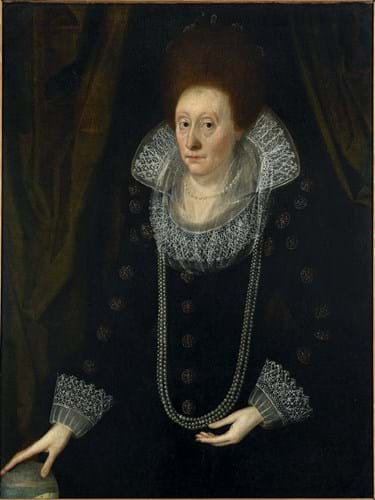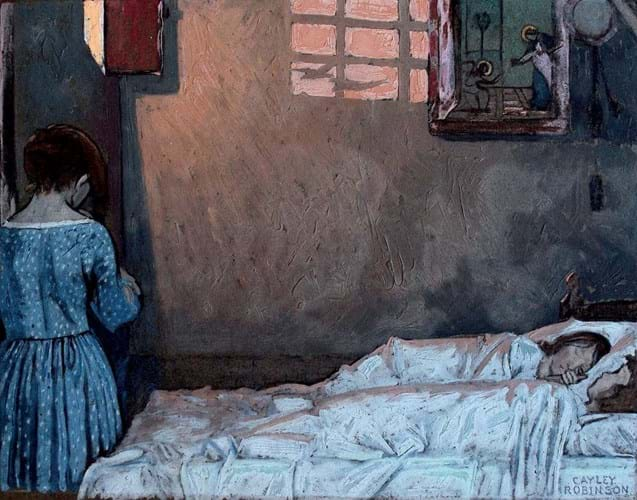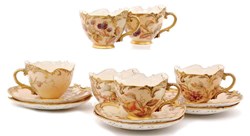
In the last 15 years of his life Walter Sickert (1860-1942) turned away from the dark and menacing scenes of his Camden Town Group days and recreated a series of brighter Victorian genre subjects.
It was an unexpected move for the artist who had been a pivotal figure in British avant-garde painting in the late 19th and early 20th centuries.
The so-called Echoes – the name Sickert gave to his pictures from this late career diversion – amounted to around 100 paintings executed in a wide palette of bold hues and based on designs found in old editions of the Illustrated London News and other 19th century periodicals.
Although popular with the public at the time, they were viewed as derivative copies and sidelined from the artist’s canon for some 40 years after his death.
Opinion has since changed. The Sickert scholar Wendy Baron described his late works as ‘perhaps the most stimulating, visually, of Sickert’s entire career’. On the secondary market, where demand is concentrated on the artist’s Camden Town material, these late works are among the more affordable oil paintings one can buy and range from around £5000-15,000 at auction.
Market fresh
An example emerged in a Pictures, Furniture, Clocks & Rugs sale at Lawrences (25% buyer’s premium) of Crewkerne on January 17 estimated at £6000-9000. Believed to have been painted around seven years before his death, the 16 x 20in (40 x 50cm), titled Second Course, Dein Freund, was based on a genre scene by the Victorian painter and illustrator Adelaide Claxton (1841-1927).
It had passed by descent to the vendor from the Earl and Countess Jowitt and before that was owned by the British socialite Margot Asquith. Fresh to the market and in good condition, it got away towards its upper guide to sell to a private buyer in the home counties for £8500.
After the sale, Lawrences picture specialist Richard Kay said: “Sickert is riding a crest of a wave as far as demand for figurative Camden Town period art is concerned. Therefore, somebody who can buy a distinctive late work like this is keen to have a go.”
Typically unsettling
An early-20th century painting by the Symbolist painter Frederick Cayley Robinson (1862-1927) attracted decent bidding, selling to the London trade for £8000, double the bottom guide. A typically unsettling work by the Brentford-born artist, the small but distinctive 6 x 8in (16 x 20cm) oil on brown paper, titled A Summer Evening, depicts a cell-like space with three women in repose.
Although the artist’s works are relatively uncommon at auction, making it difficult to build collections, “he attracts something of a cult following”, said Kay. “There are people who will buy a Cayley Robinson who might not buy other artists who are similar because they like him as a very distinctive artistic voice in this period.”

Portrait of a Lady, formerly identified as Queen Elizabeth 1, thought to be Elizabeth ‘Bess’ of Hardwick, Countess Of Shrewsbury, Circle of Marcus Gheeraerts The Younger – £10,500 at Lawrences of Crewkerne.
The top picture lot was a known 16th century half-length portrait of a lady identified as Elizabeth I in the past but more recently as a rare likeness of Bess of Hardwick, who married her way into great wealth and power in Tudor England.
The 3ft 1in x 2ft 5in (96 x 73cm) oil on canvas, catalogued as circle of Marcus Gheeraerts the Younger (c.1561-1636), depicts the sitter wearing a black dress decorated with jewelled roundels, lace collar and cuffs and a triple rope of pearls – an identical necklace is recorded in the inventory of Bess’s jewels in 1593.
The picture’s provenance stretches back to Edward Hyde, 1st Earl of Clarendon, the English statesman who served as Lord Chancellor to King Charles II. It passed by descent through the Earls of Clarendon until it sold to the vendor for £10,000 at Sotheby’s in London in December 2010. It made marginally more at Lawrences, selling for £10,500 to a private collector in London.
Princess portrait
Consigned from a separate source was a fresh-to-market contemporary portrait of an adolescent Princess Mary, the eldest daughter of Charles I and Henrietta Maria.
The 2ft 7in x 2ft (80 x 62cm) oil on canvas, depicting Mary in the guise of Diana the Huntress, was attributed to the Dutch Golden Age painter Adriaen Hanneman (c.1603-71) largely on the strength of the existence of an engraving depicting the same subject.
“It was a fine piece of painting with a rewarding clean in it,” said Kay. It sold for a mid-estimate £5000 to a regular client at the Somerset saleroom.
A small 9 x 7in (23 x 18.5cm) watercolour of a thatched cottage in Chideock, Dorset, by Helen Allingham (1848-1926) sold to a dealer for a multi-estimate £7500. Being fresh to the market and a Dorset subject (rather than the artist’s more common Surrey and Sussex themes) may have accounted for the strong price, which goes against the tide for cottage garden watercolours currently.
A bid of £7000 from a Russian buyer in London secured a late-18th century large watercolour of Jerusalem by the elusive Russian painter Gavrila Sergeyevich Sergeyev (c.1765-1816).
Estimated at £3000-5000, it was admired for its large scale, condition and subject – views of Jerusalem in the late 18th century are rare. The only other known work by Sergeyev is an apparent companion piece depicting Jerusalem in the Khalili Collection of Islamic Art in London.
It came from the collection of Niall Hobhouse, a vendor from Somerset who has consigned a number of pictures and antiques to Lawrences in the past.
A second lot from this source, a rather dirty 14 x 6in (36 x 17cm) pen and brown ink Old Master drawing of a male nude with one leg raised, catalogued as Follower of Luca Cambiaso (1527-85), was taken to £5500 by two determined bidders.















